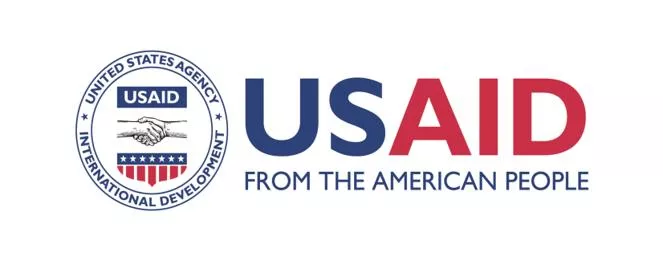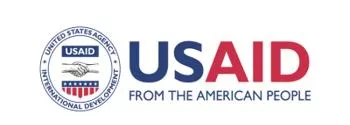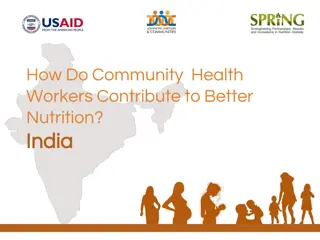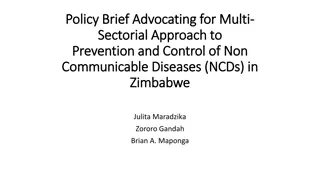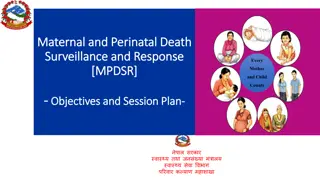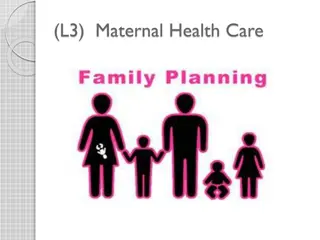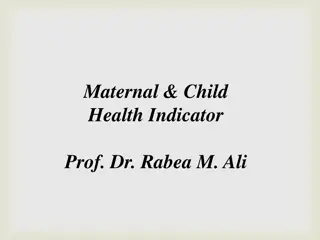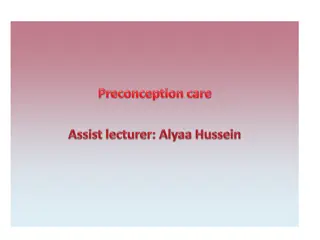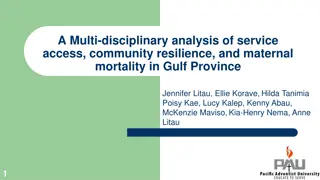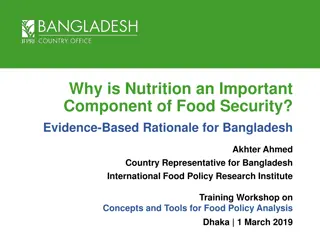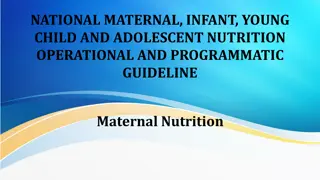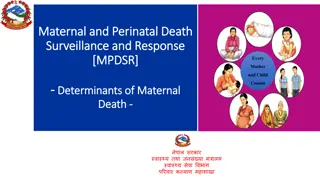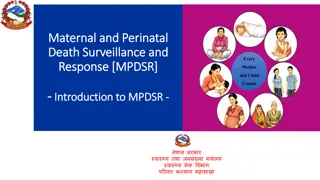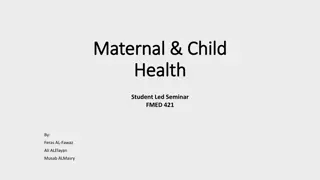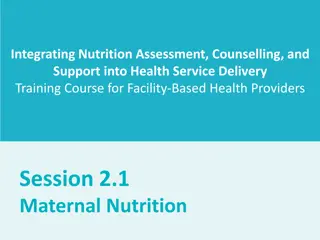Maternal Nutrition Interventions for Reducing NCDs
Maternal nutrition interventions play a crucial role in reducing nutrition-related noncommunicable diseases in Bangladesh. The country faces a growing burden of NCDs, including cardiovascular diseases, diabetes, COPD, and cancers. The life course approach to NCD prevention highlights the importance of targeting nutrition-related risk factors early on to prevent long-term health issues. Understanding intervention points for N-RNCD prevention is vital in addressing the current NCD profile in Bangladesh and implementing policy actions for effective prevention strategies.
Download Presentation

Please find below an Image/Link to download the presentation.
The content on the website is provided AS IS for your information and personal use only. It may not be sold, licensed, or shared on other websites without obtaining consent from the author.If you encounter any issues during the download, it is possible that the publisher has removed the file from their server.
You are allowed to download the files provided on this website for personal or commercial use, subject to the condition that they are used lawfully. All files are the property of their respective owners.
The content on the website is provided AS IS for your information and personal use only. It may not be sold, licensed, or shared on other websites without obtaining consent from the author.
E N D
Presentation Transcript
Leveraging Maternal Nutrition Interventions for Reducing Nutrition-Related NCDs in Bangladesh Amanda Pomeroy-Stevens SPRING Project; John Snow Inc. World Congress on Public Health Kolkata, February 14th, 2015
OUTLINE Life Course Approach to NCD Prevention Bangladesh s N-RNCD Risk Profile Modeling Future N-RNCD Risk Bangladesh Policy Background Policy Actions for Life Course N-RNCD Prevention
Some Definitions Noncommunicable disease (NCD): A disease that is not infectious and not transmissible among people. Examples include cardiovascular disease, type II diabetes, asthma, and cancer. Nutrition-related noncommunicable diseases (N-RNCDs): Noncommunicable diseases resulting from nutrition, including cardiovascular diseases (CVDs), type II diabetes and other metabolic disruptions, and some cancers. 1,000 days: The period between a child s conception and his or her second birthday.
The Life Course Approach to N- RNCD Prevention Source: Fall. 2003. The Fetal and Early Life Origins of Adult Disease. Indian Pediatrics, 40:480-502.
Intervention Points for N-RNCD Prevention Primary Before disease occurs Secondary After disease occurs but before patient notices symptoms After disease occurs and symptoms arise Tertiary Goal: Prevent damage, prevent complications, rehabilitate Goal: prevent disease from occurring Goal: diagnose and treat disease early CDC EXCITE. Module 13: Levels of disease prevention. http://www.cdc.gov/excite/skincancer/mod13.htm. WHO. 2008-2013 Action plan for the global strategy for the prevention and control of noncommunicable diseases. 2008.
Bangladeshs Current N-RNCD Profile
Bangladesh Rapidly changing epidemiological profile has accelerated NCD burden Among the NCDs, cardiovascular diseases (CVD), diabetes, chronic obstructive pulmonary disease (COPD) and cancers are most prevalent 60% of disease burden [1]. Direct costs of care for diabetes is up to 24.5% of annual income [2]. CVD, DM and Stroke cost country over 1 billion USD between 2006-15 [4]
Estimated Adult NCD Prevalence, Bangladesh 2010 [1] N-RNCD risk factors (% of Adults) Raised Glucose levels [10] N-RNCDs % of Deaths from CVD [10] Over- weight/ Obese Hyper- tension Raised Chol. Diabetes Men 19% 8% 13%/2% - 4% - Women 18% 9% 22%/5% - 4% - Total 99% had at least one NCD risk factor; ~29% had >3 risk factors 18% 8% 18%/4% - 4% 27%
Regional Variation in Pre-NCD Conditions [5] Percentage of children who are born low birth weight Percentage of women who are overweight (BMI >25) 11% Rajshahi 37% Rajshahi Sylhet 9% 38% Sylhet Dhaka 14% Dhaka 44% Dhaka Dhaka 14% 44% 13% 38% Khulna 11% Khulna 28% 39% Chittagong Barisal Chittagong Barisal 8% 8% Barisal 39% Barisal Legend Legend Lowest Lowest Medium Medium Source: National Low Birth Weight Survey of Bangladesh, 2003-2004 Highest Source: 2008 DHS, weighted estimates Highest Source: 2011 DHS, weighted estimates
Modelling Future N-RNCD Risk https://www.spring-nutrition.org/technical-areas/systems/n-rncds
SPRINGs Work on N-RNCDs ELN-NCD Model Decision Tree/Markov model to model effect of reductions in adverse birth outcomes on CVD morbidity/mortality Diabetes Review Systematic literature review of LMIC to assess evidence on linkages between adverse birth outcomes and DM Policy Work & Technical Guidance Ongoing support to provide Country and USAID mission guidance on how to better link nutrition and N-RNCD policy
Modifying Future CVD Risk [6] WHO threshold for cost effectiveness Highly cost effective is less than GDP per DALY: $743 Cost Effectiveness Ratios (CER) Long- and Short-Term Benefits 3% Discount MMS $265 ($197 $723) Cost Effective is less than three times GDP per capita per DALY: $2229 Source: World Bank 2011 GDP per capita for Bangladesh BPE $795 ($787 $1334) FP/IPI $3361 ($3320 - $4688) While survivorship had a significant confounding effect on mortality results, the results were encouraging: MMS was highly cost effective Holding IMR constant, MMS reduced modifiable CVD deaths by ~10% CERs improve by $3 to $49/DALY with the inclusion of long term effects
Future Diabetes Risk [7] Inverse relationship between BW and DM For BW below 4,000g, increasing BW by as little as 100g could translate into DM risk reductions of 5 10%. Low average BWs in LMICs mean interventions to increase BW will likely decrease DM risk, with relatively little effect on risk for BW > 4,000g Modelling risk reductions for DM difficult, missing data on affects of sex, GA, ethnicity, weight gain
Relevant Policy Time Frame Linkage to N-RNCD Health, Population and Nutrition Sector Development Program (HPNSDP) 2011-2016 One of 5 priority areas for health sector challenges in the plan is NCDs [3] HNP Strategic Investment Plan 2003-2010 Incl. prevention and control of major NCDs, suggests public sector focus on prevention (private sector focus: ICU and tertiary care services) Strategic Plan for Surveillance and Prevention of Non- Communicable Diseases in Bangladesh 2011-2015 Focuses on three main strategies: Surveillance, health promotion and prevention, and health care services National Nutrition Services Operational Plan 2011-2016 This is the primary nutrition policy document, and it is contained fully within the HPNSDP.
Policy Actions for N-RNCD Prevention Population Level It is imperative to identify how existing undernutrition programs can be leveraged to address N-RNCD prevention as children and adolescents reach adulthood. More emphasis on linking nutrition to N-RNCD programs is required, both for primary and secondary prevention [3] National stakeholder mapping needed to increase efficiency, marshal resources and harmonize advocacy More, and more regular, surveillance of both NCD and birth outcomes is needed to properly target at-risk populations [2,3,8,9]
Policy Actions for N-RNCD Prevention Provider Level Quality Build on existing nutrition counseling platforms, ensure messages for under- and over-nutrition harmonized to avoid conflicts [2,3] Reach Greater training and support to providers (including CHWs) on integrating nutrition messaging, screening and intervention into women s and young child PHC visits (Suggestions to revise ESP [2,3, 8]) Continuum of care educate patients on warning signs for N-RNCDs, about their individual risks, and linkages to secondary prevention [2]
THANK YOU https://www.spring-nutrition.org/technical-areas/systems/n-rncds
Sources 1. Bangladesh Society of Medicine, World Health Organization, DGHS, and MOHFW. 2011. Non-Communicable Disease Risk Factor Survey Bangladesh 2010. Bangladesh: WHO. World Bank. 2013. Tackling Noncommunicable Diseases in Bangladesh: Now Is the Time. Edited by Sameh El-Saharty. Directions in Development. Washington, DC: The World Bank. Bleich, SN., Tracey L. P. Koehlmoos, M Rashid, DH. Peters, and GAnderson. 2011. Noncommunicable Chronic Disease in Bangladesh: Overview of Existing Programs and Priorities Going Forward. Health Policy 100 (2 3): 282 89. Abegunde, DO et al.. 2007. The burden and costs of chronic diseases in low-income and middle-income countries. The Lancet , Volume 370 , Issue 9603 , 1929 1938 SPRING NCD Profiles :https://www.spring-nutrition.org/publications/briefs/nutrition-related-non-communicable-disease Pomeroy, A M Cunningham, A D Agostino, W Stevens, and J Wun. 2014. Phase I Report of the Early-Life Nutrition Linkages to Noncommunicable Disease (ELN-NCD) Model: Maternal Interventions to Improve Birthweight and Gestational Age, Bangladesh. Arlington, VA: SPRING Project. (Figures updated since first report using latest data) Pomeroy, A and J Wun. 2014. Linking Birth Outcomes to Diabetes Mellitus: An Exploratory Review. Arlington, VA: USAID/Strengthening Partnerships, Results, and Innovations in Nutrition Globally (SPRING) Project. Islam, A and T Biswas. 2014. Chronic Non-Communicable Diseases and the Healthcare System in Bangladesh: Current Status and Way Forward. Chronic Diseases International 1 (2): 6. World Health Organization. 2014. Noncommunicable Diseases Country Profiles 2014. Geneva, Switzerland: WHO. Alwan, A and World Health Organization. (2011). Global status report on noncommunicable diseases 2010. Geneva, Switzerland: World Health Organization 2. 3. 4. 5. 6. 7. 8. 9. 10.
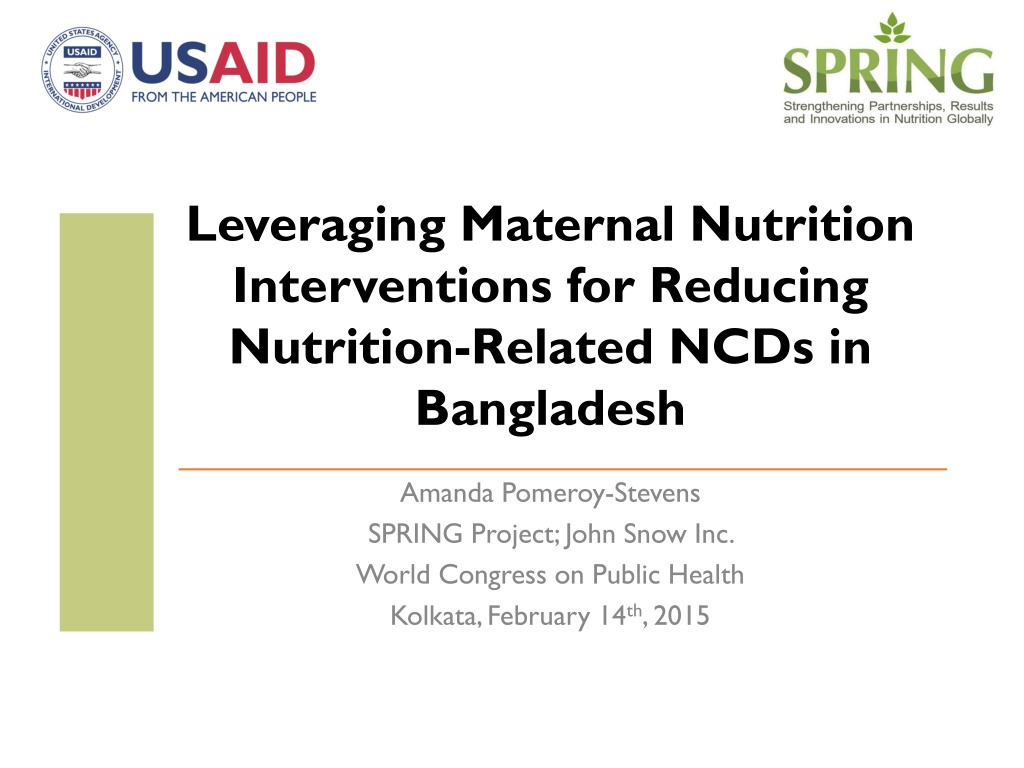
 undefined
undefined